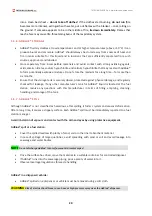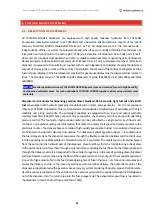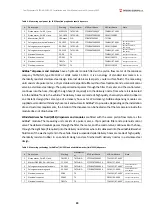
Fuel
Dispensers
TATSUNO
EUROPE
‐
Installation
and
User
Manual
,
revision
10,
January
2022
11
1.3.
BRIEF
CHARACTERISTICS
OF
MEDIA
USED
1.3.1.
CHARACTERISTICS
OF
GASOLINE
AND
DIESEL
OIL
Gasoline
(also
“petrol”)
is
a
liquid
of
oil
origin
used
mainly
as
a
fuel
in
spark
‐
ignition
engines.
It
primarily
consists
of
aliphatic
hydrocarbons
obtained
by
fractional
distillation
of
oil,
with
and
addition
of
isooctane
or
aromatic
hydrocarbons
of
toluene
and
benzene
to
increase
the
octane
number.
Small
amounts
of
different
additives
are
also
normally
added,
for
example
to
improve
engine
performance
and
decrease
harmful
emissions.
Some
mixtures
may
contain
a
significant
amount
of
ethanol
as
a
partially
alternative
fuel
(E85).
An
important
feature
of
gasoline
is
its
octane
number
which
indicates
how
resistant
gasoline
is
to
premature
detonation
ignition
(so
called
engine
knocking).
A
higher
‐
octane
number
allows
to
use
a
higher
compression
ratio
and
achieve
higher
performance.
The
EN
228
standard
specifies
a
prescribed
quality
of
unleaded
automotive
gasoline.
Diesel
oil
(rarely
“diesel”)
is
a
mixture
of
liquid
hydrocarbons.
It
is
obtained
by
distillation
and
refining
of
oil.
The
quality
of
diesel
oil
is
indicated
by
a
cetane
number
which
specifies
its
compression
‐
ignition
characteristics.
Diesel
oil
serves
(besides
other
things)
as
a
fuel
for
compression
‐
ignition
engines.
Unlike
gasoline,
diesel
may
“freeze”.
Gasoline
contains
hydrocarbons
that
have
very
good
low
‐
temperature
properties
thus
there
is
no
risk
of
gasoline
freezing.
It
is
the
other
way
round
for
diesel.
It
contains
paraffin
hydrocarbons
that
create
crystals
under
low
temperatures
and
cause
“freezing”
–
in
most
cases
a
reversible
process
of
diesel
paraffination.
The
EN
590
standard
specifies
a
prescribed
quality
of
diesel
oil.
It
also
specifies
a
distillation
curve,
burning
point,
sulphur
content,
obligatory
content
of
FAME
(Fatty
Acid
Methyl
Ester)
bio
‐
component
(currently
up
to
7%),
water,
impurities,
and
a
cetane
number.
Biodiesel
(FAME
–
fatty
acid
methyl
ester)
is
an
eco
‐
friendly
fuel
for
compression
ignition
engines
based
on
methyl
esters
of
unsaturated
fatty
acids
of
vegetable
origin.
It
is
produced
by
a
refining
process
called
transesterification.
It
can
be
used
as
a
fuel
without
any
modification
in
a
compression
ignition
engine
(diesel
engine).
The
importance
and
consumption
of
biodiesel
in
the
European
Union
still
increases.
Nowadays,
producers
must
obligatorily
add
5%
of
biodiesel
to
diesel
made
of
oil.
Mixed
motor
diesel
(rarely
Eco
‐
diesel)
is
a
motor
fuel
that
is
produced
from
classic
fossil
motor
diesel
(69%)
and
FAME
bio
‐
component
(31%).
Eco
‐
diesel
is
freely
mixable
with
standard
motor
diesel.
Thanks
to
tax
advantages
that
is
related
to
a
Europe
‐
wide
subsidy
for
fuels
from
renewable
resources
Eco
‐
diesel
is
by
approx.
2.50
to
3.00
CZK/L
cheaper
than
classic
motor
diesel.
1.3.2.
LPG
CHARACTERISTICS
LPG
is
a
commercial
name
for
a
liquefied
mixture
of
light
hydrocarbons
(
L
iquefied
P
etroleum
G
as),
mostly
with
three
to
four
carbon
atoms
in
a
molecule.
LPG
is
obtained
during
synthetic
production
of
gasoline
and
recently
also
during
natural
gas
processing.
Liquefied
LPG
is
a
colourless,
easily
volatile
liquid
of
a
specific
odour.
By
relieving
overpressure
liquefied
LPG
quickly
evaporates
and
flammable
gas
is
produced
which
is
roughly
twice
as
heavy
as
air.
By
evaporating
1
m
3
of
liquefied
LPG
(approx.
550
kg)
into
the
air
about
12.400
÷
83.330
m
3
of
an
explosive
mixture
is
created
(while
diluting
gas
to
the
lower
explosive
limit)
which
is
heavier
than
air
and
is
accumulated
at
the
ground.


























